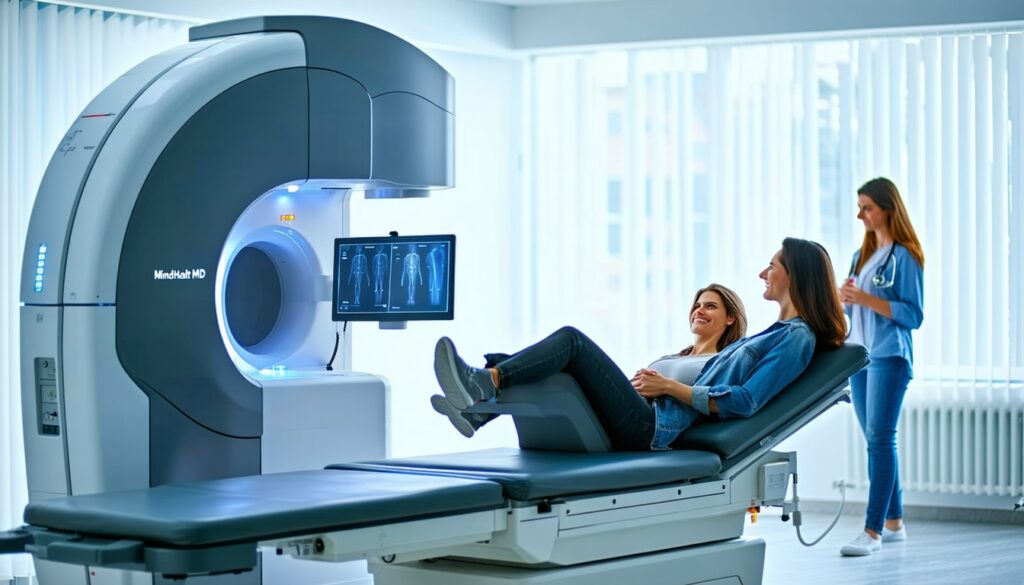Understanding PTSD and TMS
Prevalence of PTSD
Post-Traumatic Stress Disorder (PTSD) is a significant mental health issue affecting many individuals. In the United States, PTSD has a lifetime prevalence of 7–12%. It is more common among military personnel, with rates as high as 30% among veterans. Even after 10 years post-war, about 15% of these veterans continue to experience symptoms [1]. Various traumatic experiences contribute to PTSD prevalence, including combat, personal assaults, natural disasters, and motor vehicle accidents.
| Population | Lifetime Prevalence of PTSD |
|---|---|
| General Population | 7-12% |
| Veterans | Up to 30% |
| Civilians post-war | 15% (10 years post-war) |
| Women | 20.4% |
| Men | 8.2% |
Connection Between Genetics and PTSD
Genetic factors play a crucial role in the development of PTSD. Twin studies indicate that genetics can account for 30-72% of individual vulnerability to PTSD. Research has identified common variants and novel loci associated with PTSD through Genome Wide Association Studies [1].
This genetic predisposition, combined with other risk factors such as demographics, health history, cognitive characteristics, and both peri-traumatic and post-traumatic psychosocial factors, creates a complex landscape for PTSD risk and resilience.
Understanding the interplay of these factors can guide treatment decisions and highlight the importance of tailored approaches for those dealing with PTSD. For effective treatment options, consider exploring TMS for PTSD, which offers a promising alternative to traditional therapies.
Efficacy of TMS in Treating PTSD
The Science Behind TMS Therapy
Transcranial Magnetic Stimulation (TMS) therapy employs safe magnetic pulses to stimulate underperforming areas of the brain associated with mood regulation. This innovative approach is particularly crucial for individuals who experience Post-Traumatic Stress Disorder (PTSD) and have not found relief through traditional treatments. Research shows that TMS therapy can provide quicker symptom relief compared to conventional medications.
Here’s how TMS therapy works:
- Targeted Stimulation: TMS focuses on specific brain regions, such as the prefrontal cortex, which is linked to emotions and mood.
- Non-Invasive: The procedure is entirely non-invasive, making it a safe option for many individuals.
- FDA Approval: TMS therapy has been approved by the FDA for major depression, and recent studies indicate its effectiveness for PTSD, chronic depression, and even obsessive-compulsive disorder [3].
TMS as a Drug-Free Alternative
One of the most significant benefits of TMS therapy is that it provides a drug-free alternative for treating PTSD. This non-invasive treatment eradicates the risks associated with dependency and adverse drug effects, which can often accompany traditional medication therapies. TMS therapy targets the roots of emotional distress without the need for pharmaceuticals.
Here’s a comparison of TMS therapy and traditional medication therapy:
| Aspect | TMS Therapy | Traditional Medication |
|---|---|---|
| Invasiveness | Non-invasive | Invasive (requires intake) |
| Dependency Risks | Minimal | Moderate to high |
| Side Effects | Headaches, mild scalp discomfort | Varies (nausea, weight gain, etc.) |
| Speed of Relief | Quicker (weeks) | Slower (weeks to months) |
| FDA Approval | Yes (for major depression, PTSD, etc.) | Yes (for various conditions) |
Research indicates that TMS therapy offers a beneficial option for PTSD patients, especially for those who have exhausted other treatments without success. TMS is particularly attractive for individuals seeking restoration of normalcy in their lives. Discussions with a qualified TMS therapy provider can help you understand whether this innovative treatment option is right for you.
Through its targeted, drug-free approach, TMS therapy is transforming how PTSD is treated, paving the way for better mental health outcomes without the complications associated with traditional medication.
TMS Therapy for PTSD
Transcranial Magnetic Stimulation (TMS) has emerged as a promising treatment option for individuals suffering from Post-Traumatic Stress Disorder (PTSD). This section outlines its application in treating PTSD and reviews success rates based on clinical trials.
Application of TMS in PTSD Treatment
TMS therapy involves the use of magnetic fields to stimulate nerve cells in the brain. This non-invasive procedure disrupts patterns of activity in parts of the brain associated with PTSD, effectively alleviating symptoms such as distress and insomnia. Research indicates that TMS can significantly reduce these symptoms, providing a valuable alternative for those who may find traditional therapies inadequate [1].
The procedure entails several sessions where a TMS provider applies magnetic pulses to specific regions of the brain. Patients typically report minimal discomfort during sessions, which last approximately 30 to 40 minutes. This makes TMS an appealing option for individuals who prefer non-invasive and drug-free treatments.
You can find out more about the procedure and its effectiveness through our resources on transcranial magnetic stimulation therapy and non-invasive depression treatment.
Success Rates and Clinical Trials
The efficacy of TMS for PTSD has been affirmed through various randomized controlled trials (RCTs). These studies provide compelling evidence regarding the therapy’s effectiveness relative to sham treatments. A systematic review and meta-analysis highlighted that TMS has Grade ‘A’ evidence for alleviating PTSD symptoms. Statistically significant improvements were observed, particularly in key areas measured by the Clinician-Administered PTSD Scale (CAPS).
In one notable RCT conducted in Korea, findings demonstrated significant improvements in PTSD symptoms among individuals receiving active TMS treatment compared to those receiving sham treatment. The results confirmed the tolerability and effectiveness of rTMS, paving the way for its broader application as a PTSD treatment [6].
For an overview of TMS’s impact on various mental health conditions, check out our articles on TMS for treatment resistant depression, TMS for anxiety and panic, and the specific application of TMS for PTSD. This therapy offers hope and a transformative option for those seeking relief from PTSD.
Personal Experiences with TMS
Patient Testimonials and Success Stories
Many individuals struggling with PTSD have found relief through TMS (transcranial magnetic stimulation) therapy. Patients have reported transformative experiences as a result of this innovative treatment. For example, one patient described their journey as “going from hell to being alive in heaven” within just a few weeks of starting TMS therapy, noting miraculous improvements in their depression [7]. Another patient echoed similar sentiments, sharing that TMS gave them back the ability to hope after battling depression for a lifetime, with noticeable improvements and no adverse side effects [7].
| Patient Experience | Outcome |
|---|---|
| “Miraculous relief, feeling alive.” | Improved mental health within weeks. |
| “Gained hope after years of depression.” | Noticeable improvements with no side effects. |
| “Drastic improvement in anxiety and depression.” | Sense of peace and joy with minimal discomfort. |
| “The only treatment that worked for me.” | Overcame depression and anxiety, became the best version of themselves. |
Another individual shared that TMS was the only effective treatment they found, crediting it with saving their life and permitting them to thrive despite their previous struggles with anxiety and depression [7]. These testimonials illustrate the profound impact TMS can have on those experiencing PTSD.
Benefits of TMS for PTSD Patients
TMS therapy offers numerous benefits, particularly for those suffering from PTSD. It is a drug-free alternative, reducing dependence on medications, which often come with undesirable side effects. Patients can experience improvements in their mental health without the typical concerns associated with antidepressants or other traditional medications.
TMS treatment not only targets the symptoms of PTSD but also helps to improve overall quality of life. Many users report enhanced mood, increased energy levels, and improved relationships with family and friends. Clinical findings suggest that those receiving fMRI-guided, accelerated iTBS (intermittent theta burst stimulation) have shown significantly higher response and remission rates compared to those undergoing standard rTMS [8].
In summary, TMS therapy presents a variety of advantages for individuals seeking treatment for PTSD, making it a compelling choice for you or your loved ones looking for effective solutions. To explore more about how TMS can serve your needs, consider consulting a TMS therapy provider for personalized treatment options.
Comparison with Traditional Medication
TMS vs Traditional Medication Therapy
Transcranial Magnetic Stimulation (TMS) therapy provides a promising, drug-free alternative to traditional medication therapy for treating conditions such as PTSD. Unlike conventional treatments, TMS uses magnetic pulses to stimulate areas of the brain associated with mood regulation. This method acts on underperforming brain areas to facilitate quicker relief than typical antidepressants.
The following table highlights key differences between TMS and traditional medication therapy:
| Feature | TMS Therapy | Traditional Medication |
|---|---|---|
| Type of Treatment | Non-invasive | Medication-based |
| Side Effects | Minimal and temporary | Common side effects, including weight gain and fatigue |
| Treatment Time | Short sessions, typically 20-40 minutes | Daily medication regimen |
| Relief Time | Faster onset of therapeutic effects | Weeks to months for effectiveness |
| Efficacy Rate | Effective for treatment-resistant cases in over 30% of patients | Varies, with many not responding adequately |
TMS has been increasingly researched as an effective treatment for PTSD, demonstrating overall positive effects in reducing symptoms like distress and insomnia. This makes TMS a suitable option for those who have not found success with traditional medications, particularly for those struggling with treatment-resistant depression.
Integrative Care Approaches
At MindHealth MD, integrative care is emphasized to provide the best outcomes for patients. This approach combines TMS therapy with other treatments, including medication, lifestyle coaching, and talk therapy, to address the unique needs of each individual [2].
Integrative care can enhance the effectiveness of TMS for PTSD by:
- Coordinating Care: Streamlining communication among healthcare providers to ensure cohesive treatment strategies.
- Holistic Treatment Plans: Addressing underlying issues that may contribute to PTSD symptoms, such as anxiety or depression, through a combination of therapies.
- Patient Empowerment: Encouraging patients to engage in their treatment plan, promoting lifestyle changes that can enhance recovery.
For individuals considering TMS, it is vital to explore not just the therapy itself but the comprehensive care options that can further improve outcomes. Integrating various therapeutic modalities can significantly impact the management of PTSD and overall mental health.
Guiding Treatment Decisions
Evidence-Based Recommendations
When considering treatment options for PTSD, it is essential to rely on evidence-based recommendations. Research indicates that repetitive Transcranial Magnetic Stimulation (rTMS) therapy is an effective treatment for individuals suffering from PTSD. TMS therapy, particularly when applied to the left dorsolateral prefrontal cortex (DLPFC), has shown significant improvements in PTSD ratings post-treatment compared to low-frequency stimulation.
The following table summarizes key findings regarding TMS therapy for PTSD:
| Study Focus | Outcome |
|---|---|
| Target Area | Left DLPFC showed improved results |
| Symptom Reduction | Significant decrease in PTSD symptoms |
| Side Effects | Common: headache, scalp pain; rare: seizures |
| Primary Studies | TMS is a recommended therapeutic option for PTSD |
For a personalized assessment, consider speaking with a psychiatrist for PTSD to evaluate your specific needs.
RCT Results and Treatment Guidelines
Randomized control trials (RCTs) have supported the efficacy of TMS as a potential treatment for PTSD, demonstrating significant reductions in symptoms from baseline. Different subtypes of TMS therapy, such as intermittent theta burst stimulation (iTBS), have displayed promising results, particularly for improving social and occupational functioning in veterans with PTSD.
A summary of RCT results on TMS therapy is provided below:
| Study Focus | Findings |
|---|---|
| Right DLPFC Target | More effective in reducing avoidance and hyperarousal symptoms |
| Effectiveness | TMS significantly improved PTSD outcomes |
| Subtype Variability | iTBS shows promise in symptom improvement |
Utilizing TMS therapy, particularly through a reputable clinic like MindHealth MD, can offer you or your loved one a transformative treatment option. For further details on the options available, consider visiting our page about TMS treatment center or scheduling your first time TMS consultation.
By focusing on these evidence-based recommendations and understanding RCT outcomes, you can make informed decisions regarding TMS as a therapeutic option for PTSD.








